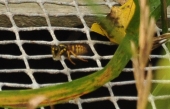Penny Dumelie wrote:
On the other side of it, I've read bees and wasps are capable of facial recognition, and I personally believe they are very aware of body language.
I'd go for that. This time of year and a bit earlier, I regularly find queen wasps in the house or the workshop. I tell them politely to leave, with suitable gesture, and they do. I would never kill a queen wasp. she is the guardian of her generation and has an important mission to fulfill.
Other end of the year, evil little sods get a swift death if they venture close to a flat surface within arm's reach!










